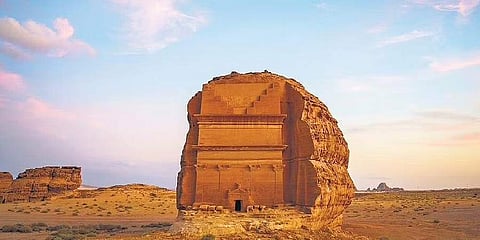
- LIFESTYLE
- FASHION
- FOOD
- ENTERTAINMENT
- EVENTS
- CULTURE
- VIDEOS
- WEB STORIES
- GALLERIES
- GADGETS
- CAR & BIKE
- SOCIETY
- TRAVEL
- NORTH EAST
- INDULGE CONNECT

Amid a desert peppered with shrubs, towering canyons and rocky outcrops lies Hegra, Saudi Arabia’s first World Heritage Site. All around, gritty mountains rise out of the flat desert-scape-like apparitions, transporting one to a civilisation that once thrived, but gradually got lost in the sands of time. Left practically undisturbed for almost 2,000 years, Hegra was thrown open to public for the first time by the Saudi government last April.
Even in the middle of this wilderness, Saudi hospitality shines through. A colourful tent fitted with carpets and plump cushions welcomes visitors as they wait for their four-wheel vehicles to tow them away for local sightseeing.
A man in white, flowing robe (known as dishdasha locally) is dispensing khaliji (fragrant coffee) from a dallah (pot) and juicy majdool dates from a bowl. Post-refreshments, Land Rovers pull up to take visitors for a spin around the 130-acre expanse of undulating sand and fascinating tombs engraved with ancient inscriptions going back millennia.
The region was once a thriving international trade hub from where the powerful Nabatean merchants controlled the incense and spice trade on the Spice Route, which winded through Arabia and Jordan right up to the Mediterranean, Egypt, Syria and Mesopotamia. The Nabateans flourished as wealthy merchants from the 4th Century BC to the 1st Century, supplying myrrh, frankincense, sugar and peppercorn via camels through the Middle Eastern region. Slowly, however, their influence waned and their civilisation faded as their land and business were taken over by the powerful Romans.
Hegra’s pièce de résistance is its rock-cut constructions that mimic its more famous sibling —Petra, a few hundred km north in Jordan. “As the principal southern city of the Nabataean Kingdom, Hegra comprises 111 well-preserved tombs of Nabataean kings and queens from the 4th BC to 1st century, many with elaborate facades surrounding the walled urban settlement. It was also the southernmost outpost of the Roman Empire after the Romans conquered the Nabataeans in 106 CE,” says rawi (guide) and storyteller Abdul, against the backdrop of the surreal landscape.
The next stop is Qasr al-Farid, a tomb of a Nabatean king going back to the first century. On one face of the iconic landmark is a carved tomb, said to be of Lihyan son of Kuza who belonged to a prominent Nabatean family. The gargantuan structure is incomplete though, with rough chisel marks at its base, signifying that the individual who commissioned this never got to be buried here.
Sphinxes, eagles, and griffins—iconic symbols in the Greek, Roman, Egyptian and Persian mythologies—mark most of the tomb’s entrances to drive away evil spirits and protect them from intruders. Others are guarded by Medusa-like masks, with snakes spiraling out as matted hair. “Hegra, also known as Mada’in Salih, features nearly 50 inscriptions of the pre-Nabataean period and some cave drawings made by the ancient people known as the Thamuds mentioned in the Quran,” Abdul explains. Ancient Nabataean agricultural sites and several artificial wells dug up in rocky ground were also found here. The 30-minute chopper tour of Hegra gives one the bird’s-eye view of the expanse.
The tombs that looked formidable from up close during the walking tour, appear like mere specks from a vertiginous height. A visit to Hegra is merely the tip of the AlUla region’s archeological treasures. The region’s other prominent heritage sites include the ancient city of Dadan, the capital of the Dadanite and Lihyanite kingdoms, which predated the Nabataeans, and Jabal Ikmah, a canyon with ancient rock inscriptions. Collectively, they offer a glimpse of a magical city that is now be lost to time.
How to reach
The nearest airport is in AlUla, a two-hour flight from Riyadh, Saudi Arabia
Best time to visit
September to March
Other must-see spots in AlUla
The ancient city of Dadan, the capital of the Dadanite and Lihyanite kingdoms, which predated the Nabataeans and Jabal Ikmah, an expansive canyon brimming with ancient rock inscriptions.